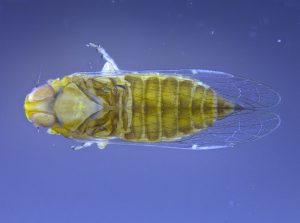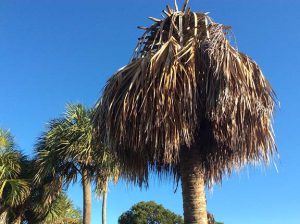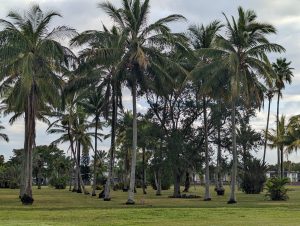-

Brian Bahder collects samples in Florida of the planthopper. Photo courtesy UF/IFAS photography. Lethal bronzing (LB) is a bacterial disease that kills more than 20 species of palm trees in the Southern United States and Caribbean and has been devastating the Florida green industries for nearly two decades.
- A University of Florida scientist at the Institute of Food and Agricultural Sciences (UF/IFAS) has identified a key chemical associated with LB infected palm trees.
- The study’s findings, published in MDPI Plants, are a landmark in plant disease research that could save nurseries and consumers from future economic loss of diseased palm trees and potentially other plant diseases.
Palm trees infected with lethal bronzing disease emit signals that warn nearby healthy palms of the threat. Those healthy palms produce their own defense that University of Florida scientists one day hope to harness to protect palms against the disease.
Entomologist Brian Bahder and his team at UF/IFAS Fort Lauderdale Research and Education Center (UF/IFAS FLREC) consider the study’s outcome a turning point for palm disease research because it has high potential for developing management strategies for lethal bronzing, a deadly disease spread by a small insect commonly called a planthopper. This discovery could help manage other palm and plant diseases.

Plants affected by disease or pests can emit small chemical signals, or volatile organic compounds, indicating they are stressed.
Those compounds warn nearby healthy plants. Those healthy plants can activate defense mechanisms — organic compounds of their own — to potentially stave off the pest responsible for the disease.
“Volatile organic compounds are common in plants and play an important role in protecting the plant,” said Bahder. “Most importantly, some of these compounds have antimicrobial properties. They have the potential for use in defending against a variety of different infections in palms and perhaps even other plants.”
“We suspected there was a chemical compound the planthopper was detecting,” said Bahder. “The goal was to identify the chemical to see if we could use it as a bait system. The resulting data showed there was a much more interesting story going on and could lay the foundation for developing a management plan for lethal bronzing and perhaps other palm diseases.”

This marks the first documented case of green leaf volatiles in palms infected by the bacteria that causes lethal bronzing.
For the study, Bahder and his team took leaf samples from infected cabbage palms, nearby threatened palm trees and healthy palm trees that were outside of the area with disease spread. All samples were taken from trees in Fort Lauderdale. Over time, they tested the plants for the disease among the three sets of palms and locations.
The lethal bronzing-infected palms gave off a specific signal, whereas the nearby palms that were healthy responded and emitted a different signal. The healthy palms that were at a distance from the infected area emitted a different signal than both the infected and threatened palms.
“The threatened palms produced a compound with known antimicrobial properties, and we are now interested in how this affects the epidemiology of lethal bronzing in the field,” said Bahder. “We hope to be able to harness these natural plant volatiles to either treat palms directly or stimulate them to produce their own defenses.”
Lethal bronzing, first detected in Tampa in 2006, transmitted by the planthopper Haplaxius crudus was confirmed as the vector in 2021. For almost two decades, the disease has been making its way steadily across the state, creating significant casualties in Florida palms.
“The most important thing to note is that once symptoms show up on the palm tree, it is too late, which is why prevention has been the first line of defense,” said Bahder.

Currently, when a tree has been infected, the only remedy is to remove it. To prevent the bacteria from spreading, the surrounding trees require sampling for phytoplasma. If the palm tests negative, then an antibiotic treatment of oxytetracycline is administered as prevention. The treatment, which is expensive, is repeated on a quarterly basis.
With the discovery of these plant-produced compounds, scientists see this as a breakthrough in developing ways to manage the disease that could allow for harnessing the plant’s own natural defenses to create a cure for infected plants that would eliminate the need for costly antibiotic treatments.
“Scientists hope to be able to harness these compounds to develop new management strategies,” said Bader.
Next stage of the research process requires additional funding to find ways to use the healthy green leaf volatiles compounds that are natural to the palm’s defense system to treat infected palms. The methods could involve injecting the compound directly into infected palms and hopefully curing the infected palm. It could also involve potentially placing dispensers or spraying areas of risk to stimulate the at-risk palms with natural defenses.
“The goal is to find cost-effective ways to protect palms whether they are over large areas that may be at risk or individual properties. Ultimately, we want to cut down on time and resources for nurseries and consumers,” said Bahder.
###
By Lourdes Mederos, rodriguezl@ufl.edu
Para accesar a esta comunicación en español, por favor utilice este enlace
ABOUT UF/IFAS
The mission of the University of Florida Institute of Food and Agricultural Sciences (UF/IFAS) is to develop knowledge relevant to agricultural, human and natural resources and to make that knowledge available to sustain and enhance the quality of human life. With more than a dozen research facilities, 67 county Extension offices, and award-winning students and faculty in the UF College of Agricultural and Life Sciences, UF/IFAS brings science-based solutions to the state’s agricultural and natural resources industries, and all Florida residents.
ifas.ufl.edu | @UF_IFAS
 3
3
